Misfire and Coolant Loss Dodge 4.7 – Possible Head Gasket
December 6, 2009 11:40 am Auto Specialty Tools, Chry. 4.7 Problems, DIY, Head Gasket Repl., How To Auto Repair, Jeep, Tech/MechanicIt’s best to eliminate the simple possibilities first when diagnosing problems with any vehicle. Coolant loss? Pressure test the cooling system and see if there’s any external leaks. But what if there are no external leaks? Then there’s a possibility that the coolant may be leaking inside the engine. Due to the combustion chamber pressure being higher than the cooling system pressure, coolant can leak into the cylinder when the engine is turned off. When the motor is running the coolant that leaked into the cylinder, will be burned in the combustion chamber and in the catalytic converter, leaving little indication of a problem since tailpipe emissions may seem normal. The 2002 Dodge Durango featured in the images had not only coolant loss, but also had a history and a stored misfire code for the number three cylinder – P0303. Someone previously had replaced the #3 spark plug in hopes of curing the problem with the misfire… needless to say it wasn’t going to be that easy. With the spark plug out and pressure testing the cooling system the #3 cylinder filled with coolant quickly. So much for a simple repair.
After further inspection, a pitted area between the coolant passage and the combustion chamber was found. Pitting like this can be caused by electrolysis – an electric charge in the cooling system. A reading may actually be taken with a meter in the coolant. Over time the electrolysis can eat away at the aluminum until the gasket can no longer seal. A cylinder head like this can be machined as long as the pits are not too deep. If the damage is too deep replacing the cyl. head is the only option.
Please reference this auto repair article when quoting, linking to this page is welcomed and appreciated. If you are new to linking a page. 1. Left click the link; to highlight 2. Right click, select copy 3. Right click and paste to forum, blog web page etc. Thanks! Disclaimer: Auto repair information/tips are designed for informational purposes only, without warranty of any kind, in no event shall the author of this site be liable for any consequential, incidental or direct damages sustained in the course of using the information in this article
Related Articles & Tools
Checking for Bent Valves – Broken Timing Belt
Car Heater Blows Cold – Auto Service Tips
Cylinder Block Test Kit
Burping Air Out of the Cooling System
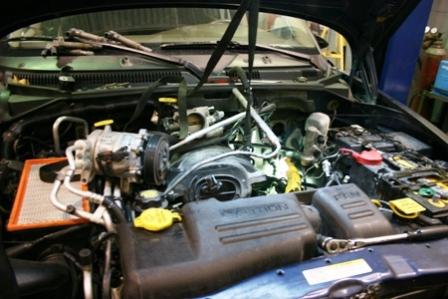
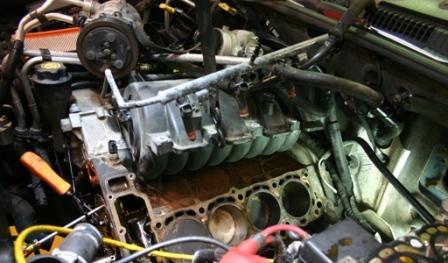
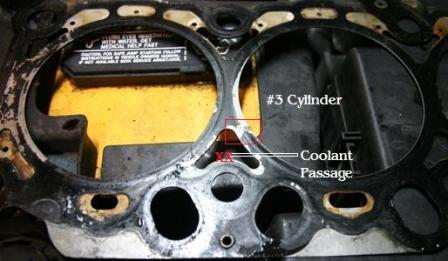
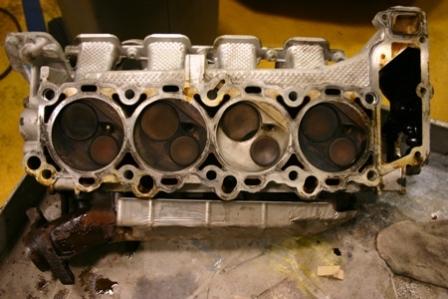
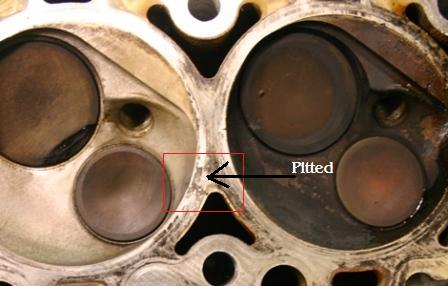
dennisb - auto tool sales :
Date: December 22, 2009 @ 7:43 am
The information in this article can be applied to other vehicles which have the same engine. The 4.7 head gasket job is basically the same no matter if it’s sitting in a Jeep or a Dodge.
Applications:
1999, 00, 01, 02, 03, 04, 05, 06, 07, 08 -2009 Jeep Grand Cherokee
2000, 2001, 2002, 2003, 2004, 2005, 2006, 2007, 2008, 2009 -Dodge Dakota
2000-2009 Dodge Durango
2002-present Dodge Ram
2006-2009 Jeep Commander
2007-2009 Chrysler Aspen
We also have the OTC 6689 cam and crank line up tools which can be used on the 4.7 and other Chrysler engines
Gary Bowman :
Date: February 6, 2010 @ 2:20 pm
My wifes’ 2003 durango is in the dealership now with a blown head gasket, 93,000 miles. Cost to repair – $ 1,800.00. If the heads are cracked cost will go to $ 3,450.00 to repair.
If this is such a common problem why has Dodge not been required to extend the warranty!!! No more Dodge products at this house, my 2002 dodge truck had same problem!
dennisb - Auto Tool Sales :
Date: February 6, 2010 @ 7:49 pm
Gary, I know what you mean. Kinda makes you long for a good old, dependable 318 or 360 ci huh?
A side note about the cylinder head in the article that was pitted. The pitted area was welded at the machine shop and then the head was machined. This was less expensive than replacing the head.
esprit :
Date: February 7, 2010 @ 6:22 pm
Many Dodge and Chryslers are sludge producing, go to carcomplaints.com and read their nightmares. I do not like to work on them and if customer calls with a broken timing belt or bearing noise, then I replace engine with Jasper engines, they improve their oil flow to the top of engine.
dennisb - Auto Tool Sales :
Date: February 7, 2010 @ 7:00 pm
Esprit, I’ve personally changed a half a dozen or so, 2.7 Intrepid engines. They had lack of oiling and sludge problems. Out of the six, one was replaced with a Jasper rebuilt engine – a little pricey but a very good looking motor.
As far as broken timing belts, I changed many of those with very few that had bent valves.
Albert Dziennik :
Date: May 29, 2010 @ 12:38 am
Engine overheated at 68,000 miles due to water pump failure. Found very poorly designed water pump with long out-bearing snout and plastic impeller. Outer bearing failure caused belt to slip causing problem. Rebuilt top end in a weekend for around $750. You can too. Just get the repair manual for torque and sequence when reassembing. You’ll need rebuilt heads ($550), head gasket set ($100), head bolt sets ($50) and more antifreeze oil filter and oil. You may need to replace plugs as well. Can be done in the driveway in a weekend, though. This engine is not difficult to work on. You can practically stand between the rediator and engine (on the ground) once you remove the fan shroud and fan. Head jobs are mandatory on most of these 4.7’s between 50,000 and 100,000 miles. Has to do with aluminum heads and iron/alloy block as well as lack of tolerability to any overheating.
dennisb - Auto Tool Sales :
Date: May 29, 2010 @ 8:25 am
Albert, Thanks for taking the time to post. Good suggestion to get rebuilt heads, when trying to complete the job in one weekend. The heads can be taken to the machine shop, and reworked for less money in many cases but there will be down time waiting for the the work to be done.
While head gasket failure is very common on these engines – I wouldn’t go as far to say that MOST will fail between 50-100,000 miles. I personally know of many 4.7’s that have well over 100,000 miles and one in a Jeep Grand Cherokee that just turned 200,000 with no head gasket issues. As you may know by reading my 4.7 Rocker Arm article, I have one of these engines myself. Knowing the rapid damage that can be done to these engines when they overheat, you can bet I’ll always be monitoring my temperature gauge!
Wayne Handy :
Date: July 30, 2010 @ 1:05 pm
I have 2002 Durango. Same problem, doing the head gaskets. 142,000 miles. Just ordered the service manual. Glad to see you can do it with out pulling the motor. Mine was strange after running for about 20-30 mins exhaust would leak into coolant system and blow all of the coolant out of the overflow.
dennisb - Auto Tool Sales :
Date: July 30, 2010 @ 6:51 pm
Yes, the service manual is a must. We recommend the on-line version (no waiting). You can print the pages with the torque info without worrying about getting them greasy.
Auto Repair Manuals
Justin :
Date: August 17, 2010 @ 9:06 pm
I have a 2007 dodge ram with this same problem, unfortunately they say the engine got hot enough to need both heads replaced. I havent heard back from the warranty adjuster yet on whether it will be covered, but I havent slept hardly a wink yet just thinking of the posibility that I will be out the cost of this repair. What upsets me the most after reading this article is that I had to go to two different dodge dealerships to get this diagnosed properly.
dennisb - Auto Tool Sales :
Date: August 17, 2010 @ 9:52 pm
Justin, good luck with the adjuster. Most are fair and honest. They look for excessive use/driving after the overheat started. Any bluing of steel indicates extended high temperatures (also excessive warpage of the heads). This may be a reason to blame some of the damage on the owner. Pitting would NOT be the fault of the driver… continuing to drive instead of having the truck towed may be though.
Thanks for taking time to post and again I hope it everything works out well.
Eli :
Date: October 29, 2010 @ 9:27 am
I had a blown head gasket on my 00 jeep grand due to a cracked thermostat housing around 173,000 miles. I took the heads off and dropped them off at Tico Racing Engines Jerome MI. Tico said most 4.7 he’s seen have been sludge engines. My heads were really clean. I’ve had a aftermarket cold air intake on the jeep for at least 100,000 miles and drive a good distance in it every day which may help with the pcv getting rid of water vapor in the engine and not building up sludge. I routinely change my oil every 4000-4500 miles. Tico shaved 6 thousandths off the heads, checked them over, cleaned them up, and installed new valves for a great price 255$. The gasket kit was 140$ and new head bolts 85$. I had some lash adjuster tick so I replaced the stock lash adjusters with some solid lash adjusters. Which were a pain to get adjusted. Broke the primary timing chain tensoner guide had to get a new one. Got it all back together and it runs like new. Thanks guys I saved lots of money and learned some things along the way.
dennisb - Auto Tool Sales :
Date: November 1, 2010 @ 8:34 am
Eli, thanks for letting us know how your head gasket repair went. Sounds like quite a job. Glad you got her up and running!
Howard :
Date: November 20, 2010 @ 7:06 pm
I must say that I’m truly shocked to read about the troubles people have had with their 4.7 engines. I bought my 07 dakota with 4.7 engine new and it just turned 100k this week.
I do mostly highway driving, probably about 80-90 percent. My engine still runs as smoothly and quietly as the day i brought it home new.
I use mobil 1 oil, and change it every 6,000 miles during the summer, and every 4,000 during the winter. I use 5w30 instead of 5/20 like the factory calls for, because oil that thin makes me a bit nervous.
Maybe the fact that i use synthetic oil and that I drive mostly on the highway is the reason that I have not had problems?
I plan to shoot for 200k, I will let you know if I have any problems before then.
Dino :
Date: January 4, 2011 @ 2:07 pm
Is there a how too anywhere on the internet on how to replace the heads on a 2002 Jeep Grand Cherokee 4.7? If you know of one can you please email me the link.
dennisb - Auto Tool Sales :
Date: January 4, 2011 @ 2:48 pm
Dino, Refer to an automotive repair manual. Follow the steps for the job including torque specs and etc.
matt :
Date: January 15, 2011 @ 1:37 pm
my 2009 dakota 4.7 has 28K on it and misfires and burns oil like crazy its been at the dealer for about two weeks and they can get it to act up but have no clue as to whats the problem….grrrrrrrr any ideas?
dennisb - Auto Tool Sales :
Date: January 15, 2011 @ 2:12 pm
Matt, there’s only a few things that would cause it to burn oil. It could be from valve guides or piston rings. You don’t really have enough miles to make me think it’s from wear. Maybe too much clearance from the beginning. Another possibility would be from the PCV system. I’m sure they will figure it out, I understand how frustrating it is though. Good Luck
Dave :
Date: February 17, 2015 @ 7:08 pm
My 2001 4.7 Dakota engine still runs great at 195,000 miles. Lot of short trips, etc. Still running strong. Had her for 14 years now! Oil changed 3-4000 miles, synthetic and part-synthetic. Water Pump and Radiator replaced around 170,000, couple of O2 sensors, Throttle Position Sensor, Cam Position Sensor all at 150,000+.
carl g :
Date: February 22, 2015 @ 9:26 pm
I have a 2004 Dakota. that’s been burning antifreeze. But when I pulled the spark plugs none of them were washed clean. I know its burning it because its not leaking externally and you can smell and see the white smoke out the exhaust. Why are none of the plugs washed clean?
dennisb - Auto Tool Sales :
Date: February 23, 2015 @ 7:28 am
I would expect at least one to show signs of coolant. I would remove the spark plugs and pressurize the cooling system and see if the coolant leaks into one of the cylinders. Good Luck.
carl g :
Date: February 23, 2015 @ 8:44 am
ok thank you ill try that tonight.
Jason :
Date: October 30, 2015 @ 10:49 pm
Hello I have a 2001 Durango, I had an H20 hose go out and had to for safety reason (as not to be killed) had to drive it to a safe shoulder, I know worst thing I could have done but truly no choice ! it now has no power runs like it is about to die and is pouring out white smoke out the exhaust, I have a feeling of what it is, but am hoping its not, and suggestion’s to fix it ? I love this rig and would love to see it back on the road.
dennisb - Auto Tool Sales :
Date: October 31, 2015 @ 9:40 am
Continuing to drive while the engine is overheating along with white smoke out of the tail pipe, indicates a blown head gasket. You can pull the plugs and pressurize the cooling system and see which cylinders are affected, but regardless I’d say a head gasket job is needed. Good Luck.
dp :
Date: August 26, 2016 @ 10:26 am
2002 dodge dakota, 4.7L. did the morning “grrrr” at startup and ran rough. Rocker had popped off. Shop replaced that lash adjuster and put the same rocker on. When it runs now, there is a tick and it shakes like one cylinder is not firing, but I don’t have any codes. I’ve reopened the passanger side valve cover. The rocker is still on. I’m going to replace all of the lash adjusters on that side. But am puzzled by the “loping” and lack of power. I did a compression test on the 4 cylinders, passenger side – all read 120. Any thoughts on what could be causing the unbalance of the motor and lack of power? Thanks!
dennisb - Auto Tool Sales :
Date: August 26, 2016 @ 12:02 pm
Missing if not from a mechanical reason is usually from spark plugs or a bad coil and sometimes from an injector or wiring. Since you had the rocker off maybe the spark plug for that cylinder is fouled.
dp :
Date: August 26, 2016 @ 4:32 pm
Wouldn’t I get a code, if I didn’t have spark?
Could it be the valves? Although compression test on that side didn’t reveal a leak. (did the test while cold, as I had the valve cover off).
dennisb - Auto Tool Sales :
Date: August 26, 2016 @ 4:55 pm
An intake valve bent or not seating properly for whatever reason should affect you compression reading on that cylinder since it would not hold pressure. Misfire’s cause a code eventually. It takes a certain number of misfires before the code will be set and the light turns on. With some scan tools, especially on Ford you can see a misfire count before the parameter is reached to set the code. Good Luck.
dp :
Date: August 26, 2016 @ 4:59 pm
Ok, thanks for your reply. I’m going to change out all the lash adjusters (just bought the tool from your site), and was going to change the spark plugs anyways. Hopefully that takes care of it!!
How hard is it to get off drivers side valve cover, in case these items on the passenger side do not solve the problem?
dennisb - Auto Tool Sales :
Date: August 26, 2016 @ 5:21 pm
Thanks for the purchase. The Win 3747-123 has been a very popular tool that takes the place of the Miller 8516A Rocker Arm Tool and the 8387 Valve Spring Compressor. As far as getting the driver’s side valve cover off; the brake power booster can be removed if necessary. Not sure if it needs to come off to allow more access. But as you can kinda see in one of the pictures above, I had it removed to gain easier access when doing the head gaskets. I did not take the brake lines loose from the power booster. I just unbolted the master cylinder and pulled it out of the way with the lines still connected as to not get air in the brake system. Then I removed the brake power booster from the vehicle completely. You may not need to do this but you have the option if needed.
Daveinet :
Date: January 28, 2017 @ 2:36 pm
I recently lost my 2001 WJ due to head gasket failure. It had a minor head gasket leak for probably 6 years. Since it only used about a gallon of anti-freeze a year, I just ignored it. Finally after about 50K miles, I had to replace the radiator. Apparently the nursing of the leaking radiator caused the head to get much worse. I had an instance where it didn’t want to crank over. I assumed a dead battery, because I do not drive it much in the summer (motorcycle season) I jump started it, and it started – and then the engine started jumping around. I shut it off, but the damage was done. Rod broke and went through the oil pan. I junked the car.
Moral of the story, if you suspect a blown head gasket, and the engine doesn’t turn over, don’t assume a dead battery – its probably hydrolocked.